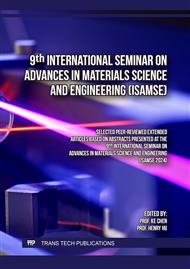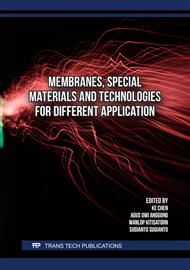p.49
p.55
p.61
p.67
p.75
p.81
p.95
p.101
p.109
Study on Preparation, Structure, and Properties of Flexible Shape Memory Epoxy Resin
Abstract:
To improve the toughness of epoxy resins, we add N, N-dimethylformamide (DMF) to epoxy resin as it is curing, and the flexible epoxy resin is prepared. According to the results of Fourier Transform Infrared Spectroscopy (FT-IR), DMF is able to effectively graft onto the epoxy resin. The glass transition temperature (Tg) of the epoxy resin drops from 99.9°C to 19.4°C, indicating a reduction in the thermodynamic stability of DMF/epoxy, according to the results of thermogravimetric analysis (TGA) and differential scanning calorimetry (DSC). According to tensile studies, DMF/epoxy's mechanical strength is decreased, but its elongation is significantly longer and enhanced by three orders of magnitude. Impact testing reveals a significant improvement in the material's hardness (from 1.67 to 15 J·cm-2). Furthermore, DMF/epoxy is flexibly bendable. Finally, the DMA test shows that DMF/epoxy can achieve good shape memory at low temperatures to room temperature.
Info:
Periodical:
Pages:
75-80
Citation:
Online since:
December 2024
Authors:
Keywords:
Price:
Сopyright:
© 2024 Trans Tech Publications Ltd. All Rights Reserved
Share:
Citation:



